#oskar strnad
Explore tagged Tumblr posts
Photo
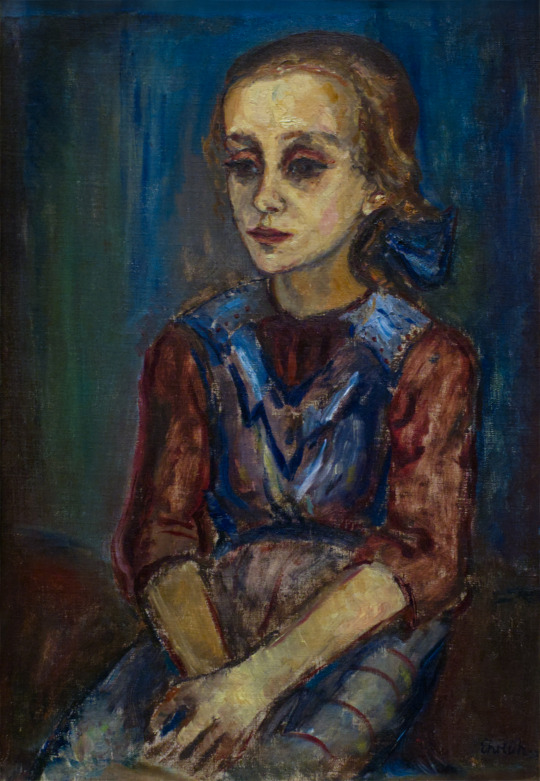
Georg EHRLICH (1897-1966) “Mädchen”- “Girl” (1922)
Öl auf Leinwand / Oil on canvas Privatsammlung Salzburg / Private collection, Salzburg Ausstellung / Exhibition HAGENBUND - Von der gemäßigten zur radikalen Moderne HAGENBUND - From moderate to radical Modernism LEOPOLD MUSEUM Wien / Vienna - 2022/23
#georg ehrlich#hagenbund#leopold museum vienna#vienna 1900#wien 1900#ehrlich#girl#mädchen#jewish#artist#vienna#wiener kunstgewerbeschule#oskar strnad#anton von kenner#Leopold Museum Wien
14 notes
·
View notes
Text
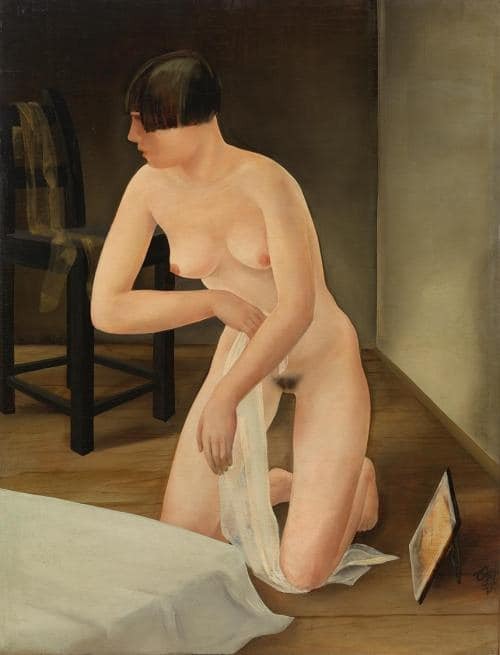
Otto Rudolf Schatz (1900 Wien – 1961 Wien), Kneeling, 1930, Oil on wood, 120 × 92 cm. Via Wien Museum.
Otto Rudolf Schatz was born on January 18, 1900, the son of a post office family in Vienna. From 1915 to 1918 Schatz studied at the Viennese Art Academy under Oskar Strnad and Anton von Kenner. In 1918 his studies were interrupted by military service in the First World War although he graduated in 1919. In 1923 Schatz became friends with the Viennese gallery owner Otto Kallir who became one of his most important patrons. Kallir continuously presented Schatz’s works in the Neue Galerie. In 1927 Schatz contributed woodcuts to the volume The New Town by the Berlin Büchergilde Gutenberg. From 1928 to 1938 he was a valued member in the Hagenbund in Vienna. When the National Socialists gained power in 1938 Schatz was forbidden to work. In 1938 he lived with his Jewish wife Valerie Wittal in Brno and in 1944 in Prague where he painted landscape miniatures. In 1944 Schatz was imprisoned in the Klettendorf labor camp and then transferred to the Graditz and Bistritz concentration camps.
44 notes
·
View notes
Text

Autoportrait (1905) | Oskar Strnad (1879-1935)
0 notes
Photo

Duplex (1932) at Werkbundsiedlung Vienna, Austria, by Oskar Strnad
225 notes
·
View notes
Photo



The Frankfurt kitchen was a milestone in domestic architecture, considered the forerunner of modern fitted kitchens, for it realised for the first time a kitchen built after a unified concept, designed to enable efficient work and to be built at low cost.
The New Dwelling sets for its occupants the task of rethinking everything afresh, organizing a new lifestyle, and of winning freedom from the irrelevant clutter of outmoded habits of thought and old-fashioned equipment. – Franz Schuster, Das neue Frankfurt (The New Frankfurt), 1927
The New Frankfurt, 1925–30
War and inflation precipitated a housing crisis in all major German cities, including Frankfurt, where the response was an ambitious program known as the New Frankfurt. This initiative encompassed the construction of affordable public housing and modern amenities throughout the city. At the core of this transformation were about 10,000 kitchens designed by Grete Schütte-Lihotzky and constructed as an integral element of the new dwelling units.
The Frankfurt Kitchen, as it was known—rational, unpretentious, and socially oriented—was conceived as one of the first steps toward building a better, more egalitarian world in the late 1920s. Under the overall direction of chief city architect Ernst May, new architectural forms, new materials, and new construction methods were applied throughout. Within five years, more than ten percent of Frankfurt’s population was living in housing and communities that were newly designed. In 1930, at the request of the Soviet Russian government, May led a “building brigade,” whose members included Schütte-Lihotzky, to implement the lessons of Frankfurt on an even larger scale in the planning of new industrial towns in the Soviet Union.
The Architect: Margarete (Grete) Schütte-Lihotzky (1897–2000)
© University of Applied Arts, Vienna
The Frankfurt Kitchen is the earliest work by a female architect in MoMA’s collection. Reminiscing about her decision to study architecture, Schütte-Lihotzky remarked that “in 1916 no one would have conceived of a woman being commissioned to build a house—not even myself.” Inspired by her mentor at the Vienna School of Applied Arts, Oskar Strnad, she became involved in designing affordable housing and worked with another Viennese architect, Adolf Loos, on planning settlements for World War I veterans.
Impressed by the functional clarity that she applied to housing problems and kitchen design in these projects, Ernst May invited her to join his Frankfurt department in 1926. She remains best known for the Frankfurt Kitchen, but her achievements as an architect working in the Soviet Union, Turkey, and Austria were more varied. During World War II her career was interrupted by four years in prison for her activities in the anti-Nazi resistance movement. In the Cold War period that followed, her professional opportunities in Austria were limited because of her continued membership in the Communist Party.
The Frankfurt Kitchen
The Frankfurt Kitchen was designed like a laboratory or factory and based on contemporary theories about efficiency, hygiene, and workflow. In planning the design, Schütte-Lihotzky conducted detailed time-motion studies and interviews with housewives and women’s groups.
Each kitchen came complete with a swivel stool, a gas stove, built-in storage, a fold-down ironing board, an adjustable ceiling light, and a removable garbage drawer. Labeled aluminum storage bins provided tidy organization for staples like sugar and rice as well as easy pouring. Careful thought was given to materials for specific functions, such as oak flour containers (to repel mealworms) and beech cutting surfaces (to resist staining and knife marks).
24 notes
·
View notes
Text
Josef Frank – Haus Scholl
1914, Wien (AT)
in collaboration with Oscar Strnad and Oskar Wlach
via #1, #2




107 notes
·
View notes
Text
Regular visit to my PAH specialist. He changed my classification of PH from NYHA III to NYHA III - IV. NYHA IV is the last phase. My heart hurts.
And I wanted yet to order subscription of the magazine Centurion about history (no sense now, right?), go to mountains Beskydy for few days to relax in swimming pool and to change scenery, when I am 24/7 at home), dye my hair, get to 25th Fantasy festival, watch new TV show of Robert Carlyle, live long enough to see 4th season of The Handmaid´s tale, new TV show of Rufus Sewell, Star Trek: Picard, new season of Altered Carbon, Atypical, The good doctor, 2nd season of After life, The Boys, War of the worlds, Umbreally academy, new season of Criminal minds, Grace and Frankie, Young Sheldon, Victoria, Dicte, watch TV show Medici and Tudors…
Get to theatre to see my favourite actors in some good play. (Jan Fišar, Tomáš Jirman, Petr Houska, František Strnad, František Večeřa, Anna Cónová, Mrs.Logojdová…) At least for the last time see play Habadůra with my favourite Mrs. Forejtová…
Catch on my knowledge of history of Korea, Japan, China, India, Russia, Mongolia, Egypt, Persia, Peru, Great Britain, Ecuador, Peru, Bolivia, Chile, Columbia, Mexiko…
Listen to everything from André Rieu, german discography of Karel Gott and Judita Čeřovská, listen to Tchaikovsky, Shostakovich, Johann Strauss father and son, Oskar Nedbal, Rudolf Piskáček, Antonín Dvořák, Bedřich Smetana etc.
To watch grow up my lovely kitten Shlomo and my little niece…
Go with my mom to running sushi, be able to prepare asian food at home.
What I will be able to manage in time I have left? I feel physically and psychologically so horrible
3 notes
·
View notes
Text
Der Wälder zarter Hauch

Scheu blickt es in der blauen Nacht durch die pflanzenverwobenen Formen hindurch, deren Gebilde eigene Welten zu sein scheinen, mit ihren Gesetzen, die das Reh nur erahnen kann. Umso interessierter und gleichzeitig zart empfindsam versucht es sie zu verstehen, obwohl sie so fremd erscheinen. Neugier und Wagemut gleichzeitig erfasst sein Herz um den unzähligen Wegen der Landschaft folgen zu können. Zartes und Scheues in der Seele sowie Zweifel und Mut gleichzeitig bestimmen seine Existenz. Das Dickicht. Die Möndin leuchtet es aus. In ihrem silbernen Kleid ist auch Diana da, das Reh beschützend, in inniger Verbundenheit und in Liebe mit den Geschöpfen des Waldes, ihren sanften Vertrauten. Aufmerksam und sensitiv ihre Hunde, die grimmig jeden Eindringling und Zerstörerer dieser glitzernden Welt, die Kostbarkeiten beschützend, zerreißen.
Treu sind die Hunde der Sibermondgöttin ergeben. Nicht Orpheus Betäubung macht ihr die Tiere untertan. Sie sind sich nah in zarter Liebe, die Mondgöttin und die Lebewesen des Waldes, wie die magischen Blumen, die im Verborgenen Dickchicht in ihren violett pink-roten und weißen Farben hervorleuchten, mit ihren verzaubernden und hypnotisierenden Düften, in Vertauen auf ihr wiederkehrendes Licht in silbernen Gewändern.
Im Moment steht das Bild noch in der Bibliothek meines Büros, des Kunst Raum Villach. Das Reh ist frei. Es wechselt seinen Standplatz, so oft es selbst will. Es befindet sich am Sessel, umgeben von zwitschernden Vögel, designed von meinem Lieblingsdesigner Josef Frank, der von den NS Schergen nach Schweden flüchtete, und ein grandioser Designer wurde. Gemeinsam mit Oskar Strnad schuf er die Wiener Schule der Architektur, die ein eigenes Konzept der Moderne von Häusern, Wohnungen und Inneneinrichtungen vertrat.
(Olivia Clementschitsch)

1 note
·
View note
Photo

josef frank, oskar wlach und oskar strnad - haus in der wilbrandtgasse, wien, 1914
184 notes
·
View notes
Text
Josef Frank
Josef Frank was an Australian architect, this was not his only profession in the a world of art and design and had a partnership with Oskar Strnad, these two boys built the Vienna school of architecture with its primal concept being modern houses housing and interior design. however before that he managed to study architecture at the Vienna university of technology and after this going on to teach in the Vienna school of arts and crafts from 1919 to 1925. During these six years he managed to influence lots of different students. After this he then went on to move to Sweden becoming the most prestigious designer in Stockholm design, dealing early with public housing and housing estates. Josef Frank received both a unique stage and invaluable help from Estrid Ericson, who was an exceptionally artistically inclined producer. He awarded her by being extremely productive: there are over 2,000 furniture sketches and 160 textile prints signed Frank in Svenskt Tenn’s archives. A freer, more artistic style ideal and he developed his own type of modernism where values like comfort, hominess and a wealth of colour were at its core. He resisted limitations and models for his furniture and textiles came from across all boundaries both in time and space. He perceived tubular steel furniture as a threat to humanity. On the contrary he wanted to include nature’s colours and forms in his interiors to be able to breathe and exude freedom even in closed rooms. For the same reason he preferred furniture that people could see through. A chair should have an open back and a cupboard should be on legs that were so high that one could distinguish the borderline between the floor and the wall. Is quite obvious a common pattern working all the way through his designs for each individual interior design work. It works around the idea of flowers beauty and and all natural resources. I found his work very complex and quite thrilling in the way that the pattern moves together and surrounds each other complimenting each design as a series. And of course when you combine all of his types of interior design work together it create a cascading effect of colour that's a vibrant and overwhelming with the flow of natural life. particularly looking at the top image

here I feel that this kind of style is truly something that I could work towards during my FMF.A display of objects with the background that truly emphasizes the colour because of the planeeie of the objects. and then particularly looking at the bottom image there is so much colour that it's so blind and thrilled with the design flaw of uncomfortable and overwhelming feeling that it is too Phil and too heavy. A common factor of all of this is the vibrant changes and colours of green, clearly representing natural life forms.
NON-WOVEN, VÅRKLOCKOR, BLACK


The prime focus of this clotted wallpaper produced by Josef Frank is the red tulips that flourish in and out of this design with it's a maximum contrast with the black bleeding background, the server emphasize the fact that its contrasting is pure and heavy they're Lilly is lined with a yellow ray. The symbolism of the lily represents perfect and deep love, creating a deep meaning to this wallpaper and a homely feel, however it spiritual meaning is forgiveness and loyalty in life. However red is at the primary colour that cinemas it's way of through this wallpaper design. The colour red in votes passion and romance strangely enough the red tulip is associated with the 11th wedding anniversary. However of course as you can see tulips are not the only plant life that are in this design. In fact plant life is quite a strong piece of symbolism and can represent many things, especially in terms of emotion. Plant life often symbolizes ideas and actions however ticket specific symbolism needs the identification of what plants.
Like most of his work green in this design is the main colour that springs out of each gap of his jumbled design. Green is a truly expressive colour. The obvious expression of green is the natural world presented by the colour that lifts and plants normally use for photosynthesis, but the often expression of tranquility is represented by the colour green. And if you think of good luck the the thought that often appears into my head is the phrase 'the luck of the Irish' this reminds me of the colour green which is presented by a four-leaf clover a wicked green and that smothers this plant.it also can represent health and thanks to herbal remedies which are also represented by plant life and the green that they use to grow along with the emotion of jealousy. As I'm sure you'll realize green is not the only colour that is vibrating its way through this design, I have previously mentioned the colour yellow which provides a warm glow and creates the maximum contrast against the black background indicating power. Yellow is associated with the sun and optimism which is quite clear because when it is a highly sunny day everyone is almost nearly always filled with the sense of joy. This is because of the vitamin d that is provided by the sun and creates a chemical reaction within the brain leading to the emotion of joy. Of course joy brings you energy which means that the colour yellow is once again associated with energy and the warm glow indicates friendship. However looking into spiritual meaning, the spiritual meaning of yellow actually is all about being comfortable in one's self, confidence which I suppose relates to the fiery blaze of the sun which is relentless and shows or pure confidence. And that the colour orange which is also presented in this design is very similar to the colour yellow, it represents joy and warmth and same as yellow it's spiritual meaning is confidence. But on the other hand orange is set to represent creativity, success encouragement and fun.in my head I can see orange representing fun because it is such an outgoing and bold colors filled with warmth and exhilarating feel. It is also set to represent balance and experimentation which ice goes hand-in-hand with the creativity. In my opinion this price of design is too over the top it overwhelmed me when I first laid eyes on it even though the colours are complementary of themselves. it's just too much to put on a wall and I feel it wouldn't have a comforting effect. Feel quite stressed looking at this design and I don't think that is a feeling and that is required or appealing in a home. However I quite like the idea of wallpaper design surrounding yourself with a pattern that you were made find thrilling to oneself.
0 notes
Photo

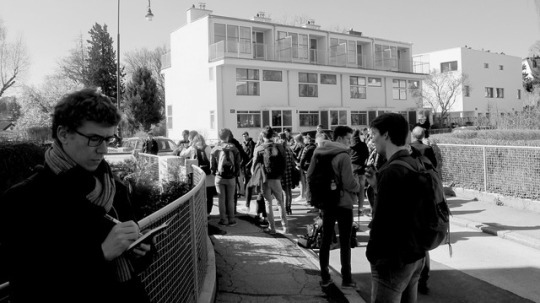
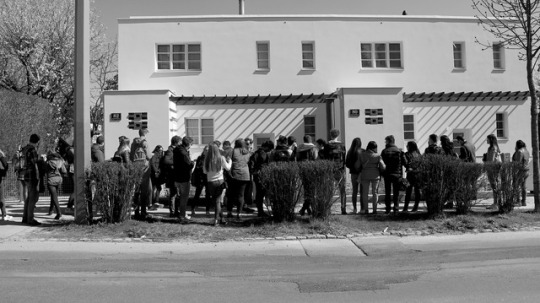


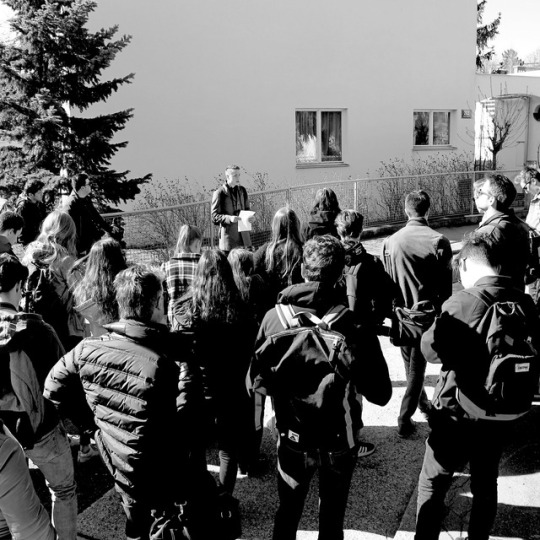



uHasselt FacArk Studio 2 bachelor architectuur, studiereis Wien 2017 Josef Frank (& Felix Augenfeld , Richard Bauer , Rudolf Baumfeld , Josef Beber , Alois Berger , Ilse Bernheimer , Hans Bichler , Karl Augustinus Bieber , Erich Boltenstern , Karl Bräuer , Anton Brenner , Otto Breuer , Josef F. Dex , Friedrich Euler , Peter Feile , Max Fellerer , Paul Fischel , László Gábor , Wolko Gartenberg , Ada Gomperz , Hugo Gorge , Jacques Groag , Arthur Grünberger , Gabriel Guévrékian , Oswald Haerdtl , Hugo Häring , Hermann John Hagemann , Josef Hoffmann , Karl Hofmann , Clemens Holzmeister , Julius Jirasek , Wilhelm Jonasch , Fritz Judtmann , Josef Ludwig Kalbac , Heinrich Kulka , Karl Lambert , Willy Legler , Ernst Lichtblau , Adolf Loos , Walter Loos , André Lurçat , Hermann Neubacher , Otto Neurath , Richard Neutra , Otto Niedermoser , Carl Panigl , Leonie Pilewski , Pierre Pinsard , Hans Pitsch , Ernst Plischke , Otto R. Polak-Hellwig , Gerrit Thomas Rietveld , Egon Riss , Marcel Roux , Grete Salzer , Margarete Schütte-Lihotzky , Hans Schlesinger , M. J. Schmidt , Heinz Siller , Walter Sobotka , Hans Soffer , Fritz Sternschein , Anton K. Strahal , Oskar Strnad , Rudolf H. Trostler , Miklos Velits , Hans Adolf Vetter , Willi Vietsch , Eugen Wachberger , Helmut Wagner-Freynsheim , Rosa Weiser , Josef Wenzel , Willy Wiesner , Egon Wiltschek , Oskar Wlach ) , Werkbundsiedlung, Wien, 1930-32
1 note
·
View note
Photo

Georg EHRLICH (1897-1966) “Kranker Knabe I” (um 1914) - “Sick Boy I” (c. 1914)
Lithographie auf Papier / Lithograph on paper Leopold Museum Wien / Vienna Ausstellung / Exhibition HAGENBUND - Von der gemäßigten zur radikalen Moderne HAGENBUND - From moderate to radical Modernism LEOPOLD MUSEUM Wien / Vienna - 2022/23
#georg ehrlich#hagenbund#leopold museum vienna#vienna 1900#wien 1900#ehrlich#sick boy#kranker knabe#wiener kunstgewerbeschule#oskar strnad#anton von kenner#leopold museum#wien#vienna
7 notes
·
View notes
Photo

Gerdago, Photo by Atelier Manassé (Adorian and Olga Wlassics), 1920s
Gerdago (1906-2004) aka Gerda Gottstein, Gerda Gottschlich, Gerda Irro, and Gerda Iro.
Born Gerda Gottstein in Vienna, she pursued art studies, first in Berlin in 1927, and then Paris in 1928-1929, where she worked as assistant to architect and stage and film designer Oskar Strnad. The name Gerdago was a professional pseudonym made up of her first name, “Gerda”, and the first two letters of her last name, “Go”.
#atelier manassé#1920s#gerdago#Gerda Gottstein#gerda gottschlich#Gerda Irro#gerda iro#olga wlassics#adorian wlassics#Wlassics#manassé#Manasse#Studio Manassé#Studio Manasse#atelier manassé wien#portrait#20s#turban#1920s turban#20s turban#weimar#weimar culture#weimar republic#1920s wien#20s wien#Olga von Wlassics#adorian von wlassics
77 notes
·
View notes
Photo

Josef Frank (July 15, 1885 – January 8, 1967) was an Austrian-born architect, artist, and designer who adopted Swedish citizenship in the latter half of his life. Together with Oskar Strnad, he created the Vienna School of Architecture, and its concept of Modern houses, housing and interiors. Love his colorful and joyful pieces🍬🍭���🌿🍀🦄 pic. lounge chair, 1930 pic.2 Anakreon print. #joseffrank#furnituredesign#interiorstyling#svenskttenn#painting#colors#emotions#interior#plantspattern#draping#soft#interioresign#pattern#textiledesign#armchairdesign#stockholm#sweden (presso Moscow) https://www.instagram.com/p/BwrBtmznb_Y/?utm_source=ig_tumblr_share&igshid=1otsu7c6jimq7
#joseffrank#furnituredesign#interiorstyling#svenskttenn#painting#colors#emotions#interior#plantspattern#draping#soft#interioresign#pattern#textiledesign#armchairdesign#stockholm#sweden
0 notes
Photo

Courtyard of the Austrian Pavilion at the Werkbund exhibition 1914 in Cologne, Germany, by Oskar Strnad
90 notes
·
View notes
Photo

House Hock (1910-12) in Vienna, Austria, by Oskar Strnad & Oskar Wlach
101 notes
·
View notes